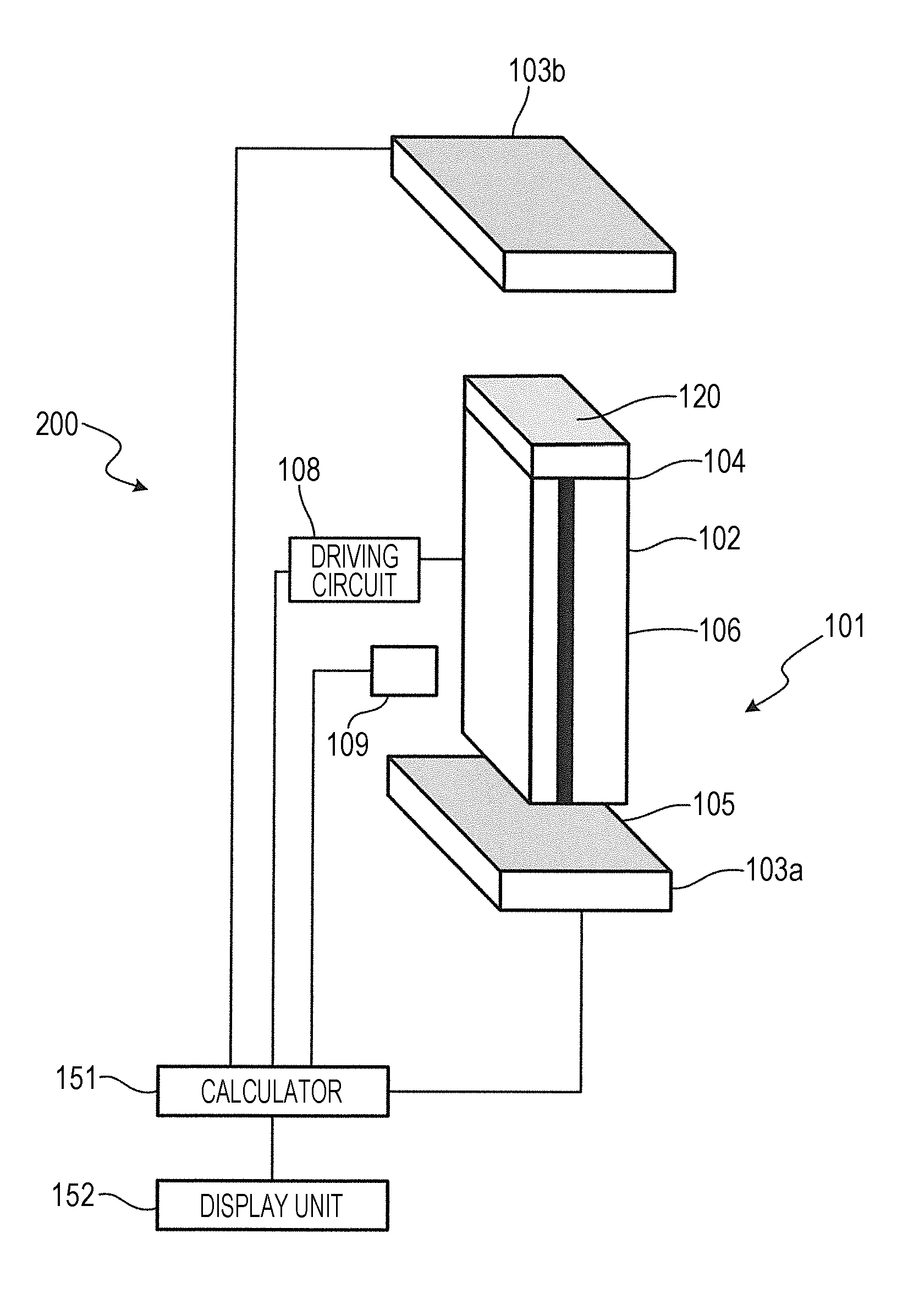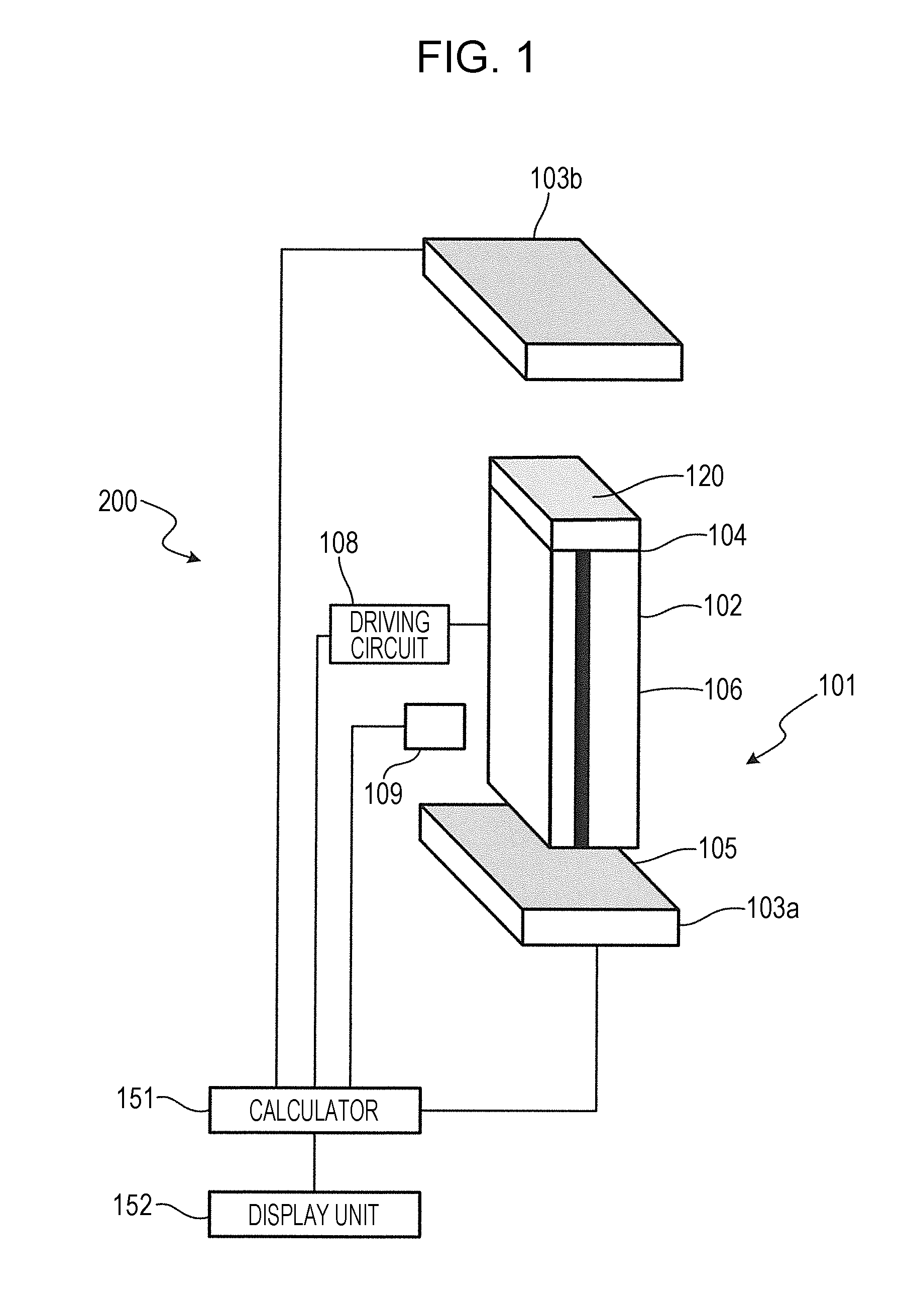Optical sensor head and optical sensor system
a sensor head and optical sensor technology, applied in the direction of phase-affecting property measurement, analysis by material excitation, instruments, etc., can solve the problems of high cost, increased size of the apparatus, difficult high-precision detection on the molecular level, etc., to achieve favorable sensitivity, reduce size, and increase sensitivity
- Summary
- Abstract
- Description
- Claims
- Application Information
AI Technical Summary
Benefits of technology
Problems solved by technology
Method used
Image
Examples
embodiment 1
[0038]The optical sensor system according to Embodiment 1 of the invention and the examples thereof will be described with reference to FIGS. 1 to 4.
[Configuration of Optical Sensor System]
[0039]The optical sensor system 200 according to the embodiment, as shown in FIG. 1, is configured from a light emitting device 102, a reactant 120, two detectors 103a and 103b, a driving circuit 108, a calculator 151, and a display unit 152. The light emitting device 102, reactant 120, and detectors 103a and 103b configure the optical sensor head 101. Although not shown in the drawings, the optical sensor head 101 is integrated by being packaged. The light emitting device 102 includes a first reflection surface 104, a second reflection surface 105 opposing the first reflection surface 104, and a waveguide 106 provided between the first reflection surface 104 and the second reflection surface 105. The reactant 120 is formed on the first reflection surface 104. The two detectors 103a and 103b are a...
example 1
[0082]For Example 1, the reflectivity R1 of the first reflection surface 104 before the reactant 120 is reacted (initial state) is 0.3 in the specific example described in FIGS. 2 to 4.
[0083]With reference to FIG. 4, in R1=0.3, it is found that the above (5) establishes either of the light intensity P1 of light radiated from the first reflection surface 104 and the light intensity P2 of light radiated from the second reflection surface 105. That is, in the case of Example 1, even if either of the light intensity P1 or the light intensity P2 is detected, it is found that the sensitivity is higher than the optical sensor system of the related art described above.
[0084]In the embodiment, the reflectivity R2 of the second reflection surface 105 becomes higher than the reflectivity R1 of the first reflection surface 104 by becoming 0.7, the light in the light emitting device 102 is not easily transmitted to the outside, and the differential efficiency η1 becomes higher than the different...
example 2
[0087]For Example 2, the reflectivity R1 of the first reflection surface 104 before the reactant 120 is reacted (initial state) is 0.7 in the specific example described in FIGS. 2 to 4.
[0088]With reference to FIG. 4, in Example 2, it is found that the above (5) establishes either of the light intensity P1 of light radiated from the first reflection surface 104 and the light intensity P2 of light radiated from the second reflection surface 105. That is, in the case of Example 2, even if either of the light intensity P1 or the light intensity P2 is detected, it is found that the sensitivity is higher than the optical sensor system of the related art described above.
[0089]With reference to FIG. 3, in a range were the reflectivity R1 is 0.45 to 0.7, it is found that the light intensity P1 of light radiated from the first reflection surface 104 is reduced slightly as the reflectivity R1 of the first reflection surface 104 increases. Accordingly, if the reflectivity R1 of the first reflec...
PUM
| Property | Measurement | Unit |
|---|---|---|
| aspect ratio | aaaaa | aaaaa |
| light intensity | aaaaa | aaaaa |
| reflectivity R1 | aaaaa | aaaaa |
Abstract
Description
Claims
Application Information
 Login to View More
Login to View More - R&D
- Intellectual Property
- Life Sciences
- Materials
- Tech Scout
- Unparalleled Data Quality
- Higher Quality Content
- 60% Fewer Hallucinations
Browse by: Latest US Patents, China's latest patents, Technical Efficacy Thesaurus, Application Domain, Technology Topic, Popular Technical Reports.
© 2025 PatSnap. All rights reserved.Legal|Privacy policy|Modern Slavery Act Transparency Statement|Sitemap|About US| Contact US: help@patsnap.com



